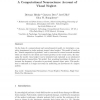Free Online Productivity Tools
i2Speak
i2Symbol
i2OCR
iTex2Img
iWeb2Print
iWeb2Shot
i2Type
iPdf2Split
iPdf2Merge
i2Bopomofo
i2Arabic
i2Style
i2Image
i2PDF
iLatex2Rtf
Sci2ools
IJON
2002
2002
A computational neuroscience account of visual neglect
On the basis of a computational and neurodynamical model, we investigate a cognitive impairment in stroke patients termed visual neglect. The model is based on the "biased competition hypothesis" and is structured in several network modules which are related to the dorsal and ventral pathway in the visual cortex. By damaging the model, visual neglect can be simulated and explained as an unbalanced neurodynamical competition. We predict that acquiring knowledge of objects can increase the frequency of saccades to previously ignored object parts. This prediction is confirmed in a single case study by monitoring eye movements of a neglect patient. Key words: Computational Neuroscience, Visual Neglect, Prediction, Single Case Study, Eye Movements
| Added | 22 Dec 2010 |
| Updated | 22 Dec 2010 |
| Type | Journal |
| Year | 2002 |
| Where | IJON |
| Authors | Dietmar Heinke, Gustavo Deco, Josef Zihl, Glyn W. Humphreys |
Comments (0)

